The state of Arizona is home to 40 kinds of snakes, a whopping 21 species of venomous snakes, and 15 of those are rattlesnakes. In fact, this state has more venomous snake species than anywhere in the U.S. But which of these potentially deadly species are the top largest (and most dangerous) snakes in Arizona? Of Arizona’s amazing array of venomous snakes, rattlesnakes are regarded as Arizona’s largest and most deadly species. But which takes the title for the biggest, most deadly snake in the state? Time to find out!
When it comes to Arizona’s fifteen distinct species of rattlesnakes, it’s hard to make a call on which is the biggest, most deadly snake on the list! However, seven of these rattlesnakes stand out as the largest venomous snakes in the state. But size is only one factor in this showdown, and two rattlers on the list may differ in size, but one is clearly more dangerous! We’ll start off with the smallest rattlesnake on the list, the aptly named Arizona black rattlesnake!

Arizona Black Rattlesnake
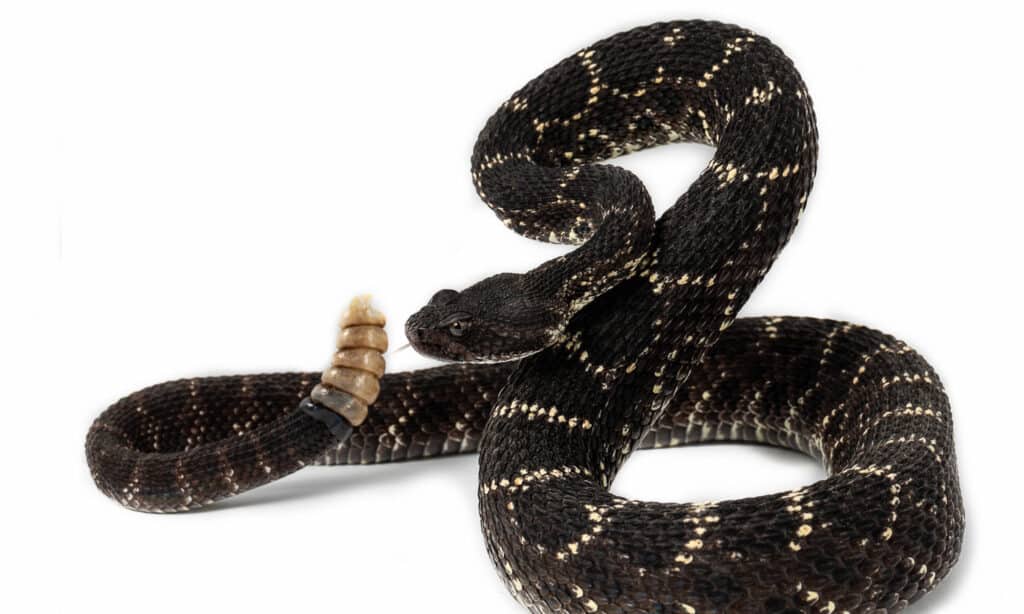
The Arizona black rattlesnake is the seventh largest venomous snake in Arizona.
©Scott Delony/Shutterstock.com
| Size | Up to 42 inches long |
| Habitat | Forests, wooded areas, high altitudes |
| Threat | Moderately venomous, bites can be deadly without medical care |
| Behavior | Mildly aggressive, most bites occur through accidental contact |
The Arizona black rattlesnake can be identified by its dark brown/nearly black coloring that masks other markings when mature. Juvenile snakes are light grey/brown overall, with darker brown/black oval or rectangular markings. Young snakes also have darker markings over the head and snout that give a mask-like appearance. Additionally, this species often changes colors depending on the environment!
In Arizona, this species is found in moist locations such as forests or wooded areas that are at higher altitudes. However, this is also one of the rarest species of rattlesnakes in North America and is listed as a Species Of Greatest Conservation Need (SGCN) by the New Mexico Department Of Game And Fish.
The Northern Black-Tailed Rattlesnake
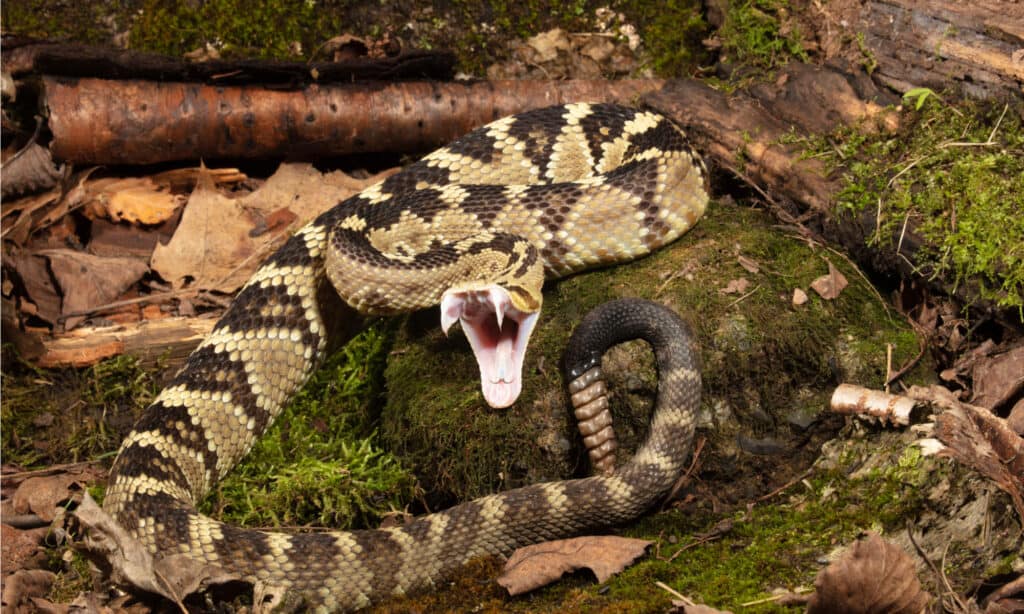
The Northern black-tailed rattlesnake is Arizona’s sixth-largest venomous snake.
©Joe McDonald/Shutterstock.com
| Size | Up to 48 inches long |
| Habitat | Rocky areas, deserts, grasslands, boreal/high pine forests |
| Threat | Venomous, bite is dangerous but rarely deadly |
| Behavior | Mild aggression, most bites occur through accidental contact |
Northern black-tailed rattlesnakes can be identified by their vibrant overall yellow/yellow green/yellow-brown coloring. Their most distinct identifying marking is the black tip of their tails, which stops at the rattle. Other markings are the black diamond-shaped patterns along the back and dark eye markings.
In Arizona, the Northern black-tailed rattlesnake can be found in all areas of the state, except for the northeast. Though they commonly prefer desert or rocky areas, this species is also known to be good at climbing trees too!
Northern Speckled Rattlesnake
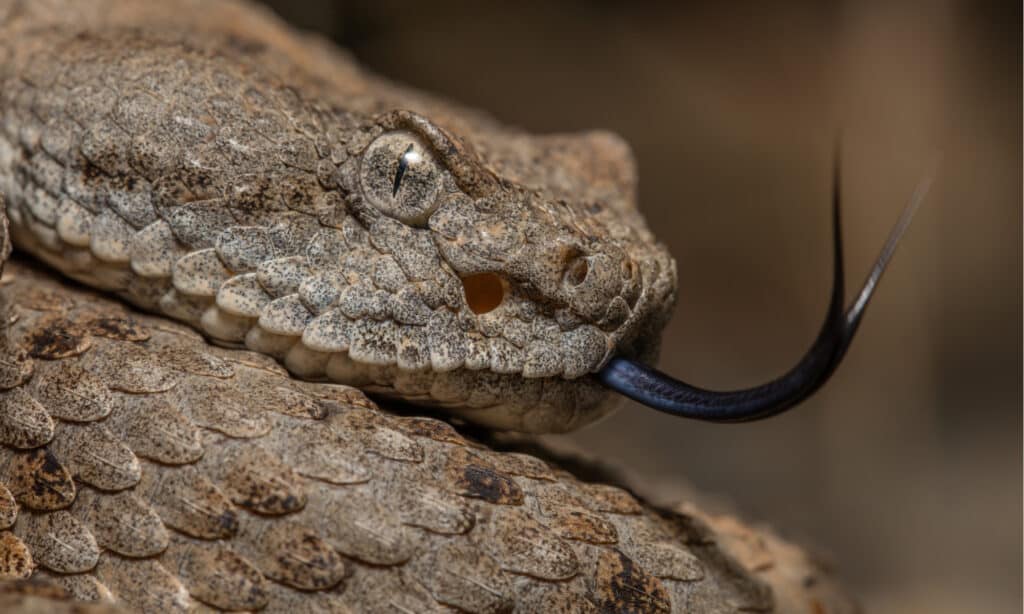
The Northern speckled rattlesnake is the fifth largest venomous snake in Arizona.
©Alexander Wong/Shutterstock.com
| Size | Up to 51 inches long |
| Habitat | Deserts, rocky areas, scrubland |
| Threat | Venomous, bites are rarely fatal but can cause death without prompt medical care |
| Behavior | Moderately aggressive, but highly reclusive. Most bites occur through accidental contact. |
Speckled rattlesnakes are identified by their unique colorations and the spotted markings for which they are named. Arizona’s speckled rattlesnakes are most commonly reddish-brown overall but can be off-white, light brown/tan, grey, yellow, orange, or pink. Markings include the species’ darker speckling and rings, which go the length of the snake’s body.
In Arizona, speckled rattlesnakes are most found in the rocky or desert locations of the state’s western region. Their unique colors and markings make them next-level experts at camouflage, even in the rattlesnake world. However, even though this snake may tempt you to take a closer look, listen to that unmistakable rattle and keep a respectful distance!
Grand Canyon Rattlesnake (Western Rattlesnake)
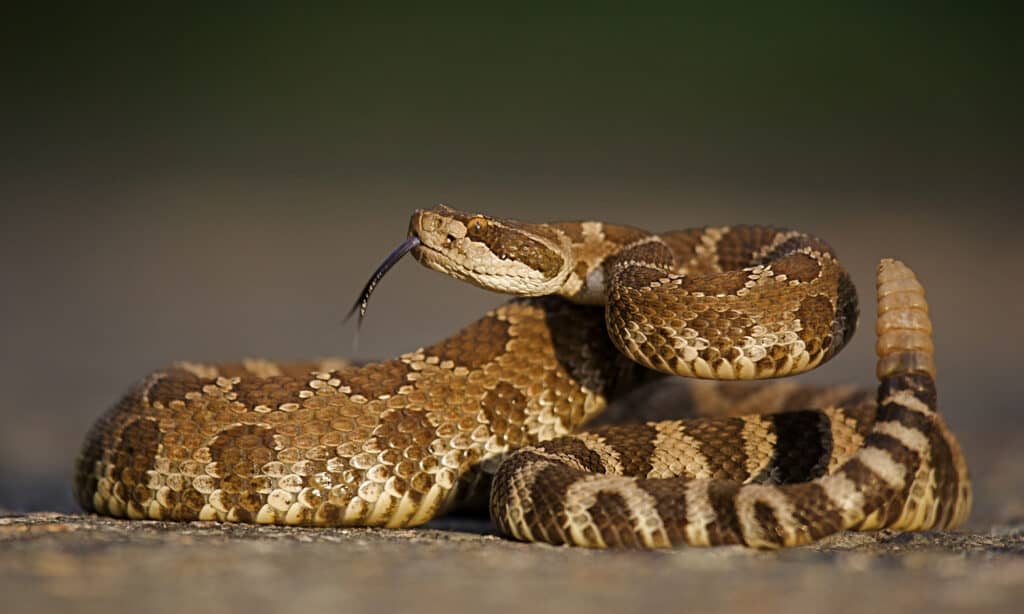
The Grand Canyon subspecies of the Western rattlesnake is Arizona’s fourth largest venomous snake.
©Tom Reichner/Shutterstock.com
| Size | Up to 60 inches long |
| Habitat | Exclusively found at or near the Grand Canyon |
| Threat | Venomous, bites can become fatal without medical treatment |
| Behavior | Mildly aggressive, will strike if threatened. Only one reported bite since the discovery of the subspecies. |
The Grand Canyon rattlesnake is a subspecies of the western rattlesnake that can be identified by its unique pink overall coloring. Markings range from darker pink to light brown/tan, red, light green, or grey. This distinct combination of colors is an evolutionary adaptation to its canyon habitat.
This rattlesnake subspecies can only be found in or near the Grand Canyon, which is in the central and northeastern region of Arizona. This subspecies is so rare, that it even has its own urban legend. According to Edwin McKee, the naturalist who discovered the subspecies, he simply picked up the specimen he took to the San Diego Zoo and carried it to his car by hand. Whether or not this story is the truth or just a tall tale, it’s a fitting legend for this stunning reptile!
Prairie Rattlesnake

The Prairie rattlesnake is the third largest venomous snake in Arizona.
©Max Allen/Shutterstock.com
| Size | Up to 64 inches long |
| Habitat | Prairies, grasslands, flatlands |
| Threat | Venomous, bite can be fatal without medical attention |
| Behavior | Moderately aggressive, most bites occur through accidental contact |
The prairie rattlesnake can be identified by its overall brown/tan/red/orange overall coloring, which varies depending on the environment. Other markings include darkly rimmed white blotching over the entire body and texturized scales.
In Arizona, this species is also commonly called the Great Plains rattlesnake and is primarily found in northeastern regions of the state. Though many believe that all snakes hatch from eggs, prairie rattlesnakes give birth to live young. These baby snakes are born self-sufficient, but often live in communal groups until they grow up and it gets too crowded!
Mojave Rattlesnake
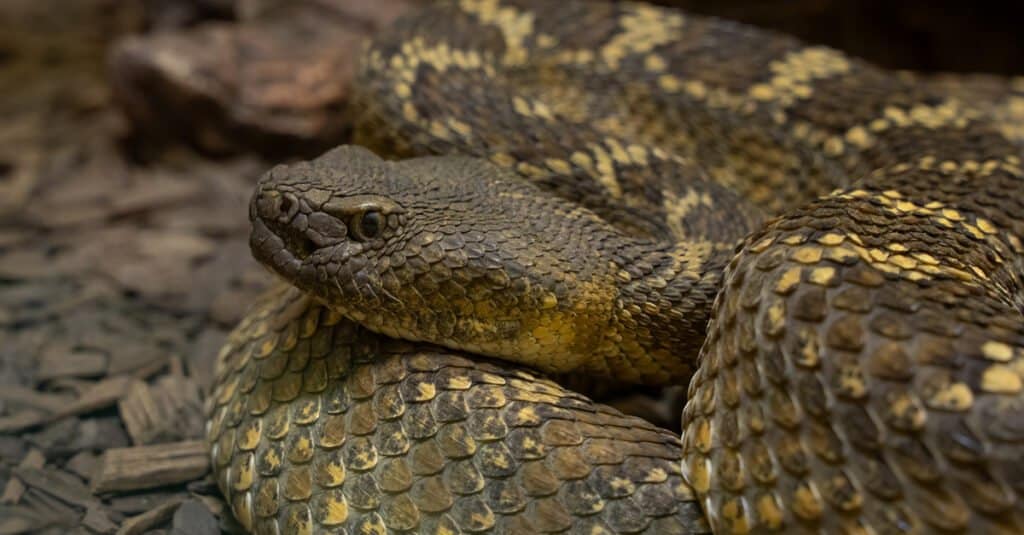
The Mojave rattlesnake is the second largest venomous snake in Arizona, and is the most deadly snake in the United States.
©J.A. Dunbar/Shutterstock.com
| Size | Up to 50 inches long |
| Habitat | Deserts, plains, grasslands |
| Threat | Venomous, most deadly snake in the United States |
| Behavior | Mildly aggressive and timid, but will strike if threatened |
The most dangerous snake in Arizona is the mojave rattlesnake. Mojave rattlesnakes found in Arizona can be identified by their overall brown or green color and darker diamond-shaped blotches that span the length of the body. Green hues are stronger in lower elevations, whereas brown is more common in higher elevations. Mojave rattlesnakes also have one distinctive band of white right above the rattle.
This species can be found throughout most of Arizona and is the deadliest snake in the United States. This is due to the dual toxins found in Mojave rattlesnake venom, which contains a highly potent combination of hemotoxins and neurotoxins. However, while its venom is far more deadly than the western diamondback, its rather timid nature makes the mojave less dangerous overall!
Western Diamondback Rattlesnake
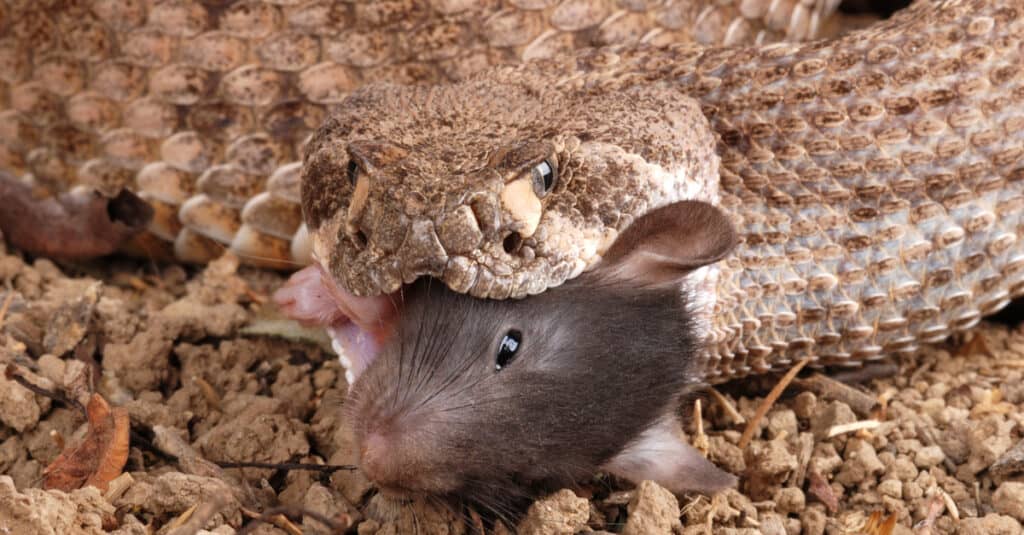
Western diamondback rattlesnakes are the largest, most dangerous snake in Arizona!
©Audrey Snider-Bell/Shutterstock.com
| Size | Up to 66 inches long |
| Habitat | Deserts, plains, flatlands, arid or dry locations |
| Threat | Venomous, bite is deadly without prompt medical treatment |
| Behavior | Highly aggressive, quick to strike and easily agitated |
The largest and most dangerous snake in Arizona is the western diamondback rattlesnake. western diamondbacks are identified by its overall tan/light grey coloring and dark brown/white outlined “diamondback” pattern. Additionally, the western diamondback has distinct black and white tail bands that end directly above the rattle.
Western Diamondbacks In Arizona
Western rattlesnakes are found throughout the state of Arizona, as well as the southwestern part of the United States. This is the largest species of venomous snake in the state. The western diamondback is the most well-known rattlesnake species in every area it lives in. This is primarily due to its reputation for being quick to strike, far quicker than any other rattlesnake species.
Honorable Mention: Arizona Coral Snakes
Our list only covers the largest of the venomous snakes and their willingness to bite. However, there is one other rather petitly-sized venomous snake in Arizona that deserves a mention. The Arizona coral snake is a highly venomous elapid and a cousin to snakes like cobras.
Although its venom is very dangerous, bites are not common because it’s very shy and only rarely seen. Arizona coral snakes only measure about 24 inches long as adults and are only a little bigger around than a pencil.
Up Next
- Discover The 8 Largest Animals In Arizona, And Where You’ll Find Them
- 40 Types Of Snakes In Arizona (21 Are Venomous)
- 7 Black Snakes In Arizona
The photo featured at the top of this post is © Dario Sabljak/Shutterstock.com
Discover the "Monster" Snake 5X Bigger than an Anaconda
Every day A-Z Animals sends out some of the most incredible facts in the world from our free newsletter. Want to discover the 10 most beautiful snakes in the world, a "snake island" where you're never more than 3 feet from danger, or a "monster" snake 5X larger than an anaconda? Then sign up right now and you'll start receiving our daily newsletter absolutely free.
Thank you for reading! Have some feedback for us? Contact the AZ Animals editorial team.






